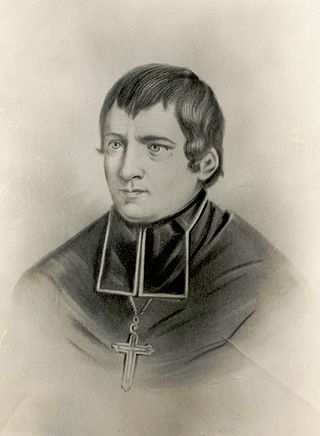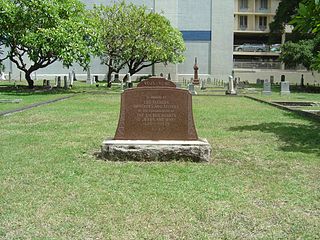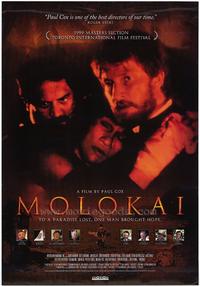
Father Damien or Saint Damien of Molokai or Saint Damien De Veuster, born Jozef De Veuster, was a Catholic priest from Belgium and member of the Congregation of the Sacred Hearts of Jesus and Mary, a missionary religious institute. He was recognized for his ministry, which he led from 1873 until his death in 1889, in the Kingdom of Hawaiʻi to people with leprosy, who lived in government-mandated medical quarantine in a settlement on the Kalaupapa Peninsula of Molokaʻi.

The Cathedral Basilica of Our Lady of Peace is the mother church and cathedral of the Diocese of Honolulu.

The Roman Catholic Bishop of Honolulu is the diocesan bishop of the Catholic Diocese of Honolulu in the United States, the Latin Church ecclesiastical territory over the entire state of Hawaii and the unincorporated Hawaiian Islands. The Honolulu diocese is a suffragan see in the ecclesiastical province administered by the metropolitan Archbishop of San Francisco. The Bishop of Honolulu is a member of the United States Conference of Catholic Bishops. He has two ecclesiastical seats: the Cathedral Basilica of Our Lady of Peace and the Co-Cathedral of Saint Theresa of the Child Jesus, both located in the City of Honolulu.
Joseph Anthony Ferrario was the third bishop of the Roman Catholic Diocese of Honolulu and served from 1982 to 1993.

The Roman Catholic Diocese of Honolulu is a Latin Church ecclesiastical territory or diocese for the state of Hawaii in the United States. It is a suffragan diocese in the ecclesiastical province of the metropolitan Archdiocese of San Francisco.

Bishop Stephen Peter Alencastre, SSCC was a bishop of the Roman Catholic Church who served as the fifth and last Vicar Apostolic of the Vicariate Apostolic of the Hawaiian Islands. He was also an apparent titular bishop of Arabissus.

Libert H. Boeynaems, formally Libert Hubert John Louis Boeynaems was a Belgian Catholic priest who served as the fourth vicar apostolic of the Vicariate Apostolic of the Hawaiian Islands – now the Roman Catholic Diocese of Honolulu.

Herman Koeckemann, formally Bernard Hermann Koeckemann, SS.CC.,, served as the second vicar apostolic of the Vicariate Apostolic of the Sandwich Islands — now the Roman Catholic Diocese of Honolulu — from 1881 to 1892.

Louis-Désiré Maigret, SS.CC., served as the first vicar apostolic of the Vicariate Apostolic of the Sandwich Islands, now the Roman Catholic Diocese of Honolulu. Born in Saint-Pierre-de-Maillé, France, Maigret was ordained to the priesthood as a member of the Congregation of the Sacred Hearts of Jesus and Mary on September 23, 1828, at the age of 24. As part of his missionary work, Father Maigret sailed to the Kingdom of Hawaiʻi to help build its Catholic community of native Hawaiians.

Étienne Jérôme Rouchouze SS.CC. was a French Catholic missionary in the Eastern Pacific.

The Honolulu Catholic Cemetery is a cemetery in Honolulu, Hawaii. The cemetery is for Roman Catholics and is located at 839-A South King Street, 21°18′15″N157°51′9″W. It is maintained by the Roman Catholic Diocese of Honolulu and has been the final resting place for many Roman Catholics from Honolulu before 1930. The cemetery is closed to further burials by the Hawaii Department of Health.

Marianne Cope, OSF,, was a German-born American religious sister who was a member of the Sisters of St. Francis of Syracuse, New York, and founding leader of its St. Joseph's Hospital in the city, among the first of 50 general hospitals in the country. Known also for her charitable works, in 1883 she relocated with six other sisters to Hawaiʻi to care for persons suffering leprosy on the island of Molokaʻi and aid in developing the medical infrastructure in Hawaiʻi. Despite direct contact with the patients over many years, Cope did not contract the disease.

Saint Augustine by the Sea Catholic Church is a parish of the Roman Catholic Church of Hawaiʻi in the United States. It falls under the jurisdiction of the Diocese of Honolulu and its bishop; it is staffed by the Congregation of the Sacred Hearts of Jesus and Mary. Located at 130 Ohua Avenue, adjacent to Kalākaua Avenue in Waikiki, Saint Augustine by the Sea ministers primarily to visitors, as Waikiki contains the highest number of domestic and international visitors in the State of Hawai‘i.

Most Sacred Heart of Jesus Catholic Church in Hāwī, North Kohala, is a historic parish in the West Hawaii Vicariate of the Catholic Diocese of Honolulu. The parish campus includes an architecturally remarkable historic church, a rectory, a church cemetery, and a parish hall.

Saint Patrick Catholic Church, Honolulu is a parish in the Kaimuki district, in the East Honolulu Vicariate of the Roman Catholic Diocese of Honolulu, Hawaii. The church was consecrated under the title of St. Patrick, Bishop of Armagh. Its Romanesque architecture, as well as its fine ecclesiastical appointments such as stained glass windows and pipe organ, are attractive to prospective couples seeking nuptial rites.

Holy Ghost Catholic Church, also known as Holy Ghost Mission, is an historic octagon-shaped Roman Catholic church building on the island of Maui, located at 4300 Lower Kula Road in Waiakoa in the Kula district. It was designed by Father James Beissel and built by his parishioners who were Portuguese from the Azores and the Madeira Islands who had come to work on the local sugarcane plantation. The first mass was celebrated in it in 1895. It was consecrated in 1899 by Bishop Gulstan Ropert, the third vicar apostolic of the Vicariate Apostolic of the Sandwich Islands — now the Roman Catholic Diocese of Honolulu.

Molokai: The Story of Father Damien is a 1999 biographical film of Father Damien, a Belgian priest working at the Kalaupapa Leprosy Settlement on the Hawaiian island of Molokai. It was directed by Paul Cox.

Ambrose Kanoealiʻi or Ambrose Kanewaliʻi Hutchison was a long-time Native Hawaiian resident of the Kalaupapa Leprosy Settlement on the island of Molokaʻi who resided there for fifty-three years from 1879 to his death in 1932. During his residence, he assumed a prominent leadership role in the patient community and served as luna or resident superintendent of Kalaupapa from 1884 to 1897.

Sacred Heart Church-Punahou is located at 1701 Wilder Avenue, in Honolulu, in the U.S. state of Hawaii. The church was dedicated in 1914, and its adjacent Bachelot Hall was dedicated in 1923. The property's rectory was built in 1927. It was added to the National Register of Historic Places listings on February 6, 2001.





















